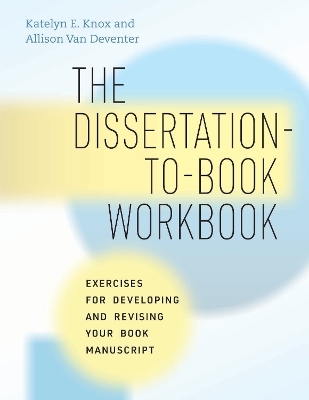
The Dissertation-to-Book Workbook
University of Chicago Press (Verlag)
978-0-226-82581-6 (ISBN)
So, you’ve written a dissertation. Congratulations! But how do you turn it into a book? Even if you know what to do when revising your dissertation, do you know how to do those things? This workbook by Katelyn E. Knox and Allison Van Deventer, creators of the successful online Dissertation-to-Book Boot Camp, offers a series of manageable, concrete steps with exercises to help you revise your academic manuscript into publishable book form.
The Dissertation-to-Book Workbook uses targeted exercises and prompts to take the guesswork out of writing a book. You’ll clarify your book’s core priorities, pinpoint your organizing principle, polish your narrative arc, evaluate your evidence, and much more. Using what this workbook calls “book questions and chapter answers,” you’ll figure out how to thread your book’s main ideas through its chapters. Then, you’ll assemble an argument, and finally, you’ll draft any remaining material and revise the manuscript. And most important, by the time you complete the workbook, you’ll have confidence that your book works as a book—that it’s a cohesive, focused manuscript that tells the story you want to tell.
Indispensible to anyone with an academic manuscript in progress, the prompts, examples, checklists, and activities will give you confidence about all aspects of your project—that it is structurally sound, coherent, free of the hallmarks of “dissertationese," and ready for submission to an academic publisher.
Katelyn E. Knox is an associate professor of French at the University of Central Arkansas. She is the author of Race on Display in 20th- and 21st-Century France. Allison Van Deventer is a freelance developmental editor for academic authors in the humanities and qualitative social sciences.
Introduction: The What, Why, and How of This Workbook
This Workbook’s Origins
An Overview of the Work You’ll Do
How This Workbook Invites You to Work
Practice 1: Prioritize Action
Practice 2: Aim for Progress, Not Perfection
Practice 3: Reflect Intentionally and Capture Doubts
Practice 4: Build Confidence by Asking Challenging Questions
What You Won’t Do in This Workbook
Decide Whether to Publish a Book or Articles
Answer Questions about Your Book’s Publishability or Your Argument’s Significance
Complete Your Book Manuscript
Copyedit Your Book’s Prose
Identify Your Book’s Target Audience and Possible Publishers
Draft Your Book Proposal
Gain Procedural Information on Publication
How to Use This Workbook
Completing the Workbook Exercises
Recommended Pacing
A Final Note: You Aren’t Alone!
Chapter 1: Considering Your Book on Its Own Terms
What to Expect
Time Investment
Common Discoveries in Chapter 1
Common Stumbling Blocks
Exercises
Step 1: Describing Your Book on Its Own Terms
Step 2: Understanding the Alignment Between Scope, Claims, and Evidence
Step 3: Troubleshooting Misaligned Claims, Scope, and Evidence
Step 4: Freewriting to Assess Your Book as a Book
Debrief, Support, and Troubleshooting
Chapter 2: Reviewing Your Book’s Organizing Principle
What to Expect
Time Investment
Common Discoveries in Chapter 2
Common Stumbling Blocks
Exercises
Step 1: Recognizing Organizing Principles
Step 2: Identifying Your Book’s Current Primary Organizing Principle
Step 3: Imagining All of Your Book’s Potential Organizing Principles
Step 4: Stating the Implied Questions
Step 5: Choosing Your Organizing Principle
Step 6: Reflecting on Your Organizing Principle
Debrief, Support, and Troubleshooting
Chapter 3: Drafting Your First Book Question
What to Expect
Time Investment
Common Discoveries in Chapter 3
Common Stumbling Blocks
Exercises
Step 1: Understanding Book Questions
Step 2: Stress-Testing the Actors and Actions of Your Book Question
Step 3: Revising Your Question Word
Step 4: Checking Your Book Question Candidates Against Your Chapters
Debrief, Support, and Troubleshooting
Chapter 4: Drafting Your Remaining Book Questions
What to Expect
Time Investment
Common Discoveries in Chapter 4
Common Stumbling Blocks
Exercises
Step 1: Selecting Other Book Questions
Step 2: Brainstorming Questions Related to Book Question 1
Step 3: Stress-Testing and Answering Your Book Questions
Debrief, Support, and Troubleshooting
Chapter 5: Revising Your Book Questions
What to Expect
Time Investment
Common Discoveries in Chapter 5
Common Stumbling Blocks
Exercises
Step 1: Checking Actors and Actions
Step 2: Stress-Testing Your Terminology
Step 3: Assessing Conceptual Relationships
Step 4: Projecting Your Chapter Answers
Debrief, Support, and Troubleshooting
Chapter 6: Assessing Your Chapters on Their Own Terms
What to Expect
Time Investment
Common Discoveries in Chapter 6
Common Stumbling Blocks
Exercises
Step 1: Producing Chapter Snapshots
Step 2: Surveying Your Chapters Within Your Book
Step 3: Assessing the Alignment Between Your Chapters’ Evidence, Scope, and Claims
Step 4: Evaluating Your Chapters’ Corpus
Step 5: Adding Metacommentary
Debrief, Support, and Troubleshooting
Chapter 7: Checking Your Chapters for Parallelism
What to Expect
Time Investment
Common Discoveries in Chapter 7
Common Stumbling Blocks
Exercises
Step 1: Identifying Constants and Variables
Step 2: Evaluating Your Book’s Variables
Step 3: Handling Outlier Chapters
Debrief, Support, and Troubleshooting
Chapter 8: Crafting Your Book’s Narrative Arc
What to Expect
Time Investment
Common Discoveries in Chapter 8
Common Stumbling Blocks
Exercises
Step 1: Describing Your Chapter Order
Step 2: Playing with Chapter Order
Step 3: Settling on a Final Chapter Order
Step 4: Identifying Narrative Interest
Step 5: Laying Out Connections and Shifts Between Consecutive Chapters
Debrief, Support, and Troubleshooting
Chapter 9: Producing Your Chapter Answers
What to Expect
Time Investment
Common Discoveries in Chapter 9
Common Stumbling Blocks
Exercises
Step 1: Transforming Your Templates into Chapter Answers
Step 2: Collecting Your Key Terms
Step 3: Scrutinizing Your Terms
Step 4: Noticing and Revising
Optional Step 5: Expanding and Condensing Your Chapter Answers
Step 6: Producing the Rest of Your Chapter Answers
Debrief, Support, and Troubleshooting
Chapter 10: Revising Your Chapter Answers as a Group and Refining Your Book Questions
What to Expect
Time Investment
Common Discoveries in Chapter 10
Common Stumbling Blocks
Exercises
Step 1: Reassessing Your Terminology
Step 2: Checking for Parallelism in Actors (and Actions)
Step 3: Noticing and Revising for Directionality
Step 4: Reviewing Your Final Book Questions and Chapter Answers
Step 5: Reading Aloud
Debrief, Support, and Troubleshooting
Chapter 11: Reviewing Your Book’s Changes and Tying Up Loose Ends
What to Expect
Time Investment
Common Discoveries in Chapter 11
Common Stumbling Blocks
Exercises
Step 1: Reviewing and Reflecting on Decisions Made Along the Way
Step 2: Revisiting, Revising, and Extending Your Chapter 1 Work
Step 3: Reviewing Your Book’s Structure and Arc
Step 4: Reflecting on Your Chapters and Their Contributions
Step 5: Capturing Threads
Step 6: Dealing with Background Information
Optional Step 7: Synthesizing Dissertation and Book Differences
Debrief, Support, and Troubleshooting
Chapter 12: Assembling Your Book Argument
What to Expect
Time Investment
Common Discoveries in Chapter 12
Common Stumbling Blocks
Exercises
Step 1: Writing Your Implicit Lesson(s)
Step 2: Turning Your Book Questions into Statements
Step 3: Pulling It All Together
Debrief, Support, and Troubleshooting
Chapter 13: Assembling Your Two-Page Book Narrative
What to Expect
Time Investment
Common Discoveries in Chapter 13
Common Stumbling Blocks
Exercises
Debrief, Support, and Troubleshooting
Interlude: Transitioning from “Working on” Your Book to “Working in” Your Book
Work You’ve Done; What Lies Ahead
FAQ as You Reach This Transition Point
Am I ready to draft proposals now?
Am I ready to talk to editors now?
Which chapter(s) should I start with in Chapter 14?
What about chapters I still need to draft?
When should I plan to draft my book introduction?
How long will revisions take?
When should I plan to submit proposals?
What if I want to change my plan?
Chapter 14: Assembling a Chapter Collage
What to Expect
Time Investment
Common Discoveries in Chapter 14
Common Stumbling Blocks
Exercises
Step 1: Gathering Your Materials
Step 2: Using Your Chapter Answers to Produce a Chapter Structure and Roadmap
Step 3: Assembling One Section by Mining Your Source Material
Step 4: Making Notes and Filling Gaps
Step 5: Repeating Steps 3–4 for Each Section
Debrief, Support, and Troubleshooting
Chapter 15: Reverse Outlining Your Chapter Collage
What to Expect
Common Discoveries in Chapter 15
Common Stumbling Blocks
Exercises
Step 1: Assembling Your Materials and Preparing the Section
Step 2: Claim Tagging (Reverse Outlining) Your Paragraphs
Step 3: Function Tagging Your Paragraphs
Step 4: Generating Your “Honest Outline” of the Section
Step 5: Analyzing Your “Honest Outline” and Jotting Notes
Step 6: Creating an Aspirational Outline
Step 7: Assessing Your Aspirational Outline
Step 8: Drafting Topic Sentences to Match Your Aspirational Outline
Step 9: Fleshing Out Paragraphs by Drafting or Assembling
Step 10: Revising Your Transitions
Step 11: Repeating Steps 1–10 for the Other Body Sections
Optional Step 12: Macro Revising, Using Targeted Questions
Step 13: Adjusting Your Book Questions and Chapter Answers
Debrief, Support, and Troubleshooting
Chapter 16: Citing with Confidence
What to Expect
Common Discoveries in Chapter 16
Common Stumbling Blocks
Exercises
Step 1: Deciding Whether and Where to Cite
Step 2: Deciding How Much to Cite
Step 3: Deciding How to Cite
Debrief, Support, and Troubleshooting
Final Words
Acknowledgments
Appendixes
Appendix A: If Your Book Isn’t Based on a Dissertation
Readiness Checklist
Appendix B: If Your Scope Needs a Closer Look
Appendix C: If You’re Unsure about Your Organizing Principle Question
Step 1: Reprising Your Topic Statement
Step 2: Review—Who’s Doing What to Whom?
Step 3: Checking Against the Question Implied by the Organizing Principle
Appendix D: If Your Book Question and Chapter Answer Terms Need a Closer Look
Appendix E: If You Want Strategies for Drafting New Work
Strategy 1: Close Reading
Strategy 2: Asking and Answering Questions
Strategy 3: Distilling Your Evidence Base
Strategy 4: Dumping Everything You Know
Strategy 5: Explaining to Yourself What You See
Strategy 6: Talking as Thinking
Strategy 7: Using a Topical Outline
Appendix F: If You Want Some Tools for Micro Revising
Considering the Topic Sentence
Considering the Paragraph, Globally
Considering Each Sentence
Additional Resources for Micro Revising
Notes
Bibliography
Index
| Erscheinungsdatum | 09.11.2023 |
|---|---|
| Reihe/Serie | Chicago Guides to Writing, Editing, and Publishing |
| Zusatzinfo | 1 halftones, 176 tables |
| Sprache | englisch |
| Maße | 216 x 279 mm |
| Gewicht | 567 g |
| Themenwelt | Geisteswissenschaften ► Sprach- / Literaturwissenschaft ► Literaturwissenschaft |
| Sozialwissenschaften ► Kommunikation / Medien ► Buchhandel / Bibliothekswesen | |
| Sozialwissenschaften ► Kommunikation / Medien ► Journalistik | |
| Sozialwissenschaften ► Soziologie | |
| ISBN-10 | 0-226-82581-7 / 0226825817 |
| ISBN-13 | 978-0-226-82581-6 / 9780226825816 |
| Zustand | Neuware |
| Informationen gemäß Produktsicherheitsverordnung (GPSR) | |
| Haben Sie eine Frage zum Produkt? |
aus dem Bereich


